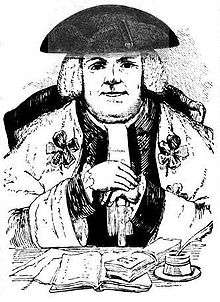David Dalrymple, Lord Hailes

Sir David Dalrymple, 3rd Baronet, Lord Hailes (October 28, 1726 – November 29, 1792) was a Scottish advocate, judge and historian, born in Edinburgh.
Family
His father, Sir James Dalrymple, 2nd Baronet, of Hailes, Haddingtonshire, Auditor of the Exchequer in Scotland, was a grandson of James Dalrymple, 1st Viscount of Stair; and his mother, Lady Christian Hamilton, was a daughter of Thomas Hamilton, 6th Earl of Haddington. The eldest of sixteen children,[1] he succeeded to his father's baronetcy upon his death in 1751.
Career
He was educated at Eton, and studied law at Utrecht. In 1748 upon his return to Scotland from Utrecht he was admitted an Advocate. It is said that as a pleader he attained neither high distinction nor very extensive practice, but he rapidly established a well-deserved reputation for sound knowledge, unwearied application and strict probity, and in 1766 he was elevated to the bench in the Court of Session where he assumed the title of Lord Hailes. Ten years later he was appointed a Lord of Justiciary.[1]
Marriage
He was twice married: (1) in 1763, to Anne, daughter of Sir George Broun, Lord Coalston, a Lord of Session, by whom he had a daughter, Christian (d.1838). He remarried (2) March 20, 1770, Helen (d. 1799), daughter of Sir James Fergusson, Baronet, of Kilkerran, Ayrshire, by whom he had another daughter, Jean (d.1803) who married her cousin, James Fergusson, Esq., and left issue.
Upon the death of Lord Hailes, his baronetcy passed to his nephew, James, 3rd Bt., the son of his brother John Dalrymple, Lord Provost of Edinburgh.
Lord Hailes as historian
Lord Hailes's most important contribution to literature was the Annals of Scotland, of which the first volume, From the accession of Malcolm III, surnamed Canmore, to the accession of Robert I, appeared in 1776, and the second, From the accession of Robert I, surnamed Bruce, to the accession of the house of Stewart, in 1779. It is, as his friend Dr Johnson justly described this work at the time of its appearance, a "Dictionary" of carefully sifted facts, which tells all that is wanted and all that is known, but without any laboured splendour of language or affected subtlety of conjecture.[1]
The other works of Lord Hailes include:
- Historical Memoirs concerning the Provincial Councils of the Scottish Clergy (1769)
- An Examination of some of the Arguments for the High Antiquity of Regiam Majestatem (1769)
- Remains of Christian Antiquity, 3 vols.
- Remarks on the History of Scotland (1773)
- Account of the Martyrs of Smyrna and Lyons in the Second Century, 1776
- The Trials of Justin Martyr, Cyprian, etc., 1778
- The History of the Martyrs of Palestine, translated from Eusebius, 1780
- Disquisitions concerning the Antiquities of the Christian Church (1783)
- editions or translations of portions of Lactantius, Tertullian and Minucius Felix.[1]
In 1786 he published An Inquiry into the Secondary Causes which Mr Gibbon has assigned for the Rapid Growth of Christianity (Dutch translation, Utrecht, 1793), one of the most respectable of the very many replies which were made to the famous 15th and 16th chapters of the Decline and Fall of the Roman Empire. A Memoir of Lord Hailes is prefixed to the 1808 reprint of his Inquiry into the Secondary Causes.[1]
Notes
- 1 2 3 4 5
 One or more of the preceding sentences incorporates text from a publication now in the public domain: Chisholm, Hugh, ed. (1911). "Hailes, David Dalrymple, Lord". Encyclopædia Britannica. 12 (11th ed.). Cambridge University Press. pp. 820–821.
One or more of the preceding sentences incorporates text from a publication now in the public domain: Chisholm, Hugh, ed. (1911). "Hailes, David Dalrymple, Lord". Encyclopædia Britannica. 12 (11th ed.). Cambridge University Press. pp. 820–821.
References
- The Extinct and Dormant Baronetcies of England, Ireland, and Scotland, by Messrs. John and John Bernard Burke, second edition, London, 1841, p. 620.
External links
- David Dalrymple, Lord Hailes at James Boswell - a Guide
- "Archival material relating to David Dalrymple, Lord Hailes". UK National Archives.
Succession Boxes
| Masonic offices | ||
|---|---|---|
| Preceded by The Duke of Atholl |
Grand Master of the Grand Lodge of Scotland 1774–1776 |
Succeeded by William Forbes, 6th Baronet |
| Baronetage of Nova Scotia | ||
| Preceded by James Dalrymple |
Baronet of Hailes, Midlothian 1751–1792 |
Succeeded by James Dalrymple |
| Scottish feudal lordship | ||
| Preceded by Sir James Dalrymple |
Lord and Baron of Hailes 1751–1792 |
Succeeded by Miss Christian Dalrymple |